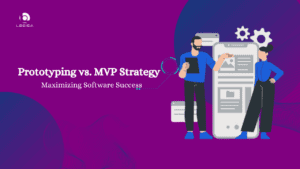Are you currently considering partnering on a software development project with another business? You’re on the correct track to maintain your competitiveness in the ever-changing tech market if you’re thinking of forming a software development partnership. Working with the proper software development business may provide you access to specialized tools, technological know-how, and cutting-edge equipment that may be hard to come by internally. By working together, you may cut expenses, accelerate time to market, and raise the caliber of your software solutions.
Numerous advantages of collaboration including greater market research, shared resources, and expertise. Not all partnerships, though, are made equal, and picking the wrong one can result in a nightmare of holdups, disagreements and cost overruns. The best part is that now you can access a few important criteria to decide whether the partner is a good firm for your software development partnerships.
In this blog, we will cover some tips for evaluating potential software development partnership. You can improve your probability of choosing a partner that shares your objectives and provides the outcomes you want for a fruitful software development project by paying attention to these tips. So, let’s get started!
Overview on software development partnership
A collaboration between two or more businesses to collaboratively develop software products or solutions is known as a software development partnership. To accomplish a shared objective, it entails sharing resources, information, and skills. Software development partnerships can take a variety of shapes, including co-development, outsourcing, and joint ventures.
Software development partnerships may have several advantages, including lower costs, a shorter time to market, enhanced creativity, and access to a bigger talent pool. The success of the initiative depends on picking the proper partner, though. To determine if possible, partners can support your objectives and provide the outcomes you want, you must evaluate their technical expertise, experience, communication skills, and project management techniques.
Clear communication, a common knowledge of the project’s scope and objectives, as well as a dedication to cooperation and openness, are necessary for successful partnerships in the software development industry. Software development partnerships may provide positive results and lasting relationships by utilizing each partner’s individual talents and cooperating to achieve a common objective.
Tips for evaluating potential software development partnership
Finding the ideal partner for your software development requirements is essential for the project’s success. Increased creativity, shared resources, and shared knowledge are just a few advantages of collaboration, but choosing the incorrect business partner may result in a nightmare of delays, disagreements, and budget overruns.
It’s important to carefully consider a partner’s technical expertise, experience, communication style, and project management procedures. You may improve your chances of success by choosing a partner who shares your objectives and can produce the outcomes you require.
A software development collaboration also has an important impact on the long-term connection between the organizations, which goes beyond the project’s success. Clear communication, a common knowledge of the project’s scope and goals, and a dedication to cooperation and openness are necessary for effective collaborations.
Devoting time and energy to choosing the ideal partner for your software development needs is therefore essential. By doing this, you can make the most of each partner’s advantages and create a long-lasting partnership that is advantageous to both businesses.
Here are some of the tips for evaluating potential software development partnership:
● Identify your requirements
Evaluating potential software development partnership requires you to first determine your needs. You can reduce your selections and make sure the businesses you choose can match your demands by being aware of what you want in a partner.
Having defined project objectives and goals is one of the key benefits of establishing your needs. You may express your demands and make sure your spouse understands them by doing this. Future misunderstandings and disagreements can be avoided in this way, improving the likelihood of a successful collaboration.
Consider your project’s needs and objectives before identifying your requirements. Think on things like your budget, timetable, and intended results. Consider the technical qualifications, background, and expertise you seek in a partner. Take into account additional elements including communication, project management techniques, and cultural fit.
Common criteria for evaluating potential software development partnership include, for instance, proficiency in a specific technology stack or programming language, experience in a particular industry, a track record of completing projects on schedule and on budget, strong communication and project management abilities, and cultural compatibility with your company.
Identifying your requirements is crucial for evaluating potential software development partnership. By knowing what you want, you can establish clear project objectives and goals, communicate your expectations, and increase the chances of a successful partnership.
● Consider experience and expertise
When evaluating potential software development partnership, experience and skill are essential variables to take into account. You can guarantee that your project will be finished on time, within budget, and to the necessary quality standards by selecting a partner with the appropriate experience and competence.
In software development, experience is important since it enables the partner to swiftly foresee and address any problems. An experienced partner may also provide viewpoints and recommendations to enhance your project, which will eventually produce a superior outcome. Furthermore, knowledge in a given sector or technology stack can assist guarantee that the partner can give you a solution that satisfies your unique objectives.
You can start by examining your partner portfolio to gauge their level of experience and knowledge. A partner’s prior work are displayed in their portfolio, which can be used to evaluate their abilities. Look for initiatives that are comparable to your own in terms of magnitude and complexity and access the effectiveness, design, quality and testing.
Also take the partner’s track record into account. A successful project delivery will show that it was completed on schedule, within budget, and with the satisfaction of the customer. Think about their years of experience in the field and whether they have knowledge of your sector or a particular technological stack.
● Look for a collaborative partner
Collaboration is one of the crucial factors when evaluating potential partnership for software development. Collaboration plays a vital role in order for software development projects to be effective and successful. A collaborative partnership is one in which both sides cooperate to achieve a common objective, exchange information and experience, and build on one another’s advantages. Better project outcomes, more efficiency, and stronger partner relationships can result from collaboration.
Look for partners that show a desire to listen and comprehend your requirements, offer ideas and criticism, and present solutions that are in line with your goals if you want to find a partner who is open to working with you. Look for partners that clarify things, ask questions, and provide opinions and recommendations during the review process.
Additionally, search for partners with a track record of client collaboration. Ask them about their methods for involving clients in the development process as well as their project management procedures. Seek out partners who will accommodate your demands and have a client-focused attitude.
Building a collaborative relationship with your partner requires effort from both parties. Start by establishing clear communication protocols and expectations, as discussed in the previous section. Ensure that both parties have a shared understanding of the project scope, goals, and requirements.
Encourage your partner to share their ideas and knowledge and provide feedback and suggestions. Create an environment where both parties feel comfortable sharing their thoughts and ideas, and actively seek out opportunities to collaborate.
● Access technical competence
For software development partnership to be effective, technical proficiency is essential. A partner with great technical capabilities can offer top-notch software solutions that are tailored to your company’s requirements. They can assist you with overcoming technical obstacles, reaching wise judgments, and utilizing cutting-edge technology to create effective and scalable software systems.
Start by looking at a possible partner’s portfolio and case studies to gauge their technical proficiency. Find partners that have a history of producing excellent results and who have expertise working on projects that are comparable to yours. Look for any honors or certificates that prove their technological knowledge.
Think about the technical staff of the partner and their credentials, experience, and knowledge. Make that the partner’s development methodology, tools, and technology meet the needs of your project by evaluating them. To verify that the software is adequately tested and meets your requirements, enquire about their quality assurance and testing procedures.
Ultimately, to learn more about their experiences working with the partner, ask for references and get in touch with some of their prior clients. Inquire about their performance overall, technical proficiency, and capacity to fulfill deadlines.
● Evaluate cultural fit
A crucial component of potential software development partnership is cultural fit, which is sometimes ignored. Communication, cooperation, and overall project success may all be improved by working with a partner who shares your organization’s culture, beliefs, and working methods. A healthy and happy working relationship between partners can also be influenced by cultural compatibility.
Assessing the business culture and values of a prospective partner is the first step in determining whether you are a good cultural match. Think about things like you’re working and communication styles, decision-making techniques, and work-life balance. To learn more about their company culture, look at their website, social media presence, and any public pronouncements.
Additionally, enquire about the prospective partner’s methods for working together, communicating with clients, and addressing problems. Take into account how adaptable and responsive they are to changes, as well as how they resolve disputes.
Establish clear expectations and norms for communication, cooperation, and decision-making to promote a healthy cultural fit throughout the relationship. Work together to resolve any potential cultural differences, such as differences in time zones or communication styles. Encourage honest and open communication and set up frequent check-ins to discuss any potential problems or concerns. Together, you may celebrate accomplishments and conquer obstacles.
● Consider partner’s location and time zone
Software development partnerships should take a partner’s location and time zone into account, especially if you are working with a remote team. Communication, cooperation, and project timescales may be impacted by your partner’s location and time zone.
Consider a partner’s location and time zone in relation to those of your organization before making your decision. Look for partners in a convenient area and time zone, such as those who have comparable office hours or who are situated in a place that is simple to go to.
Establish explicit communication guidelines and employ collaboration technologies that enable real-time communication and collaboration to handle distant relationships successfully. To make sure that everyone is on the same page and that the project is moving along as planned, schedule regular check-ins and meetings.
Potential software development partnerships need to take into account a partner’s location and time zone, particularly if you are working with a remote team. Establish explicit communication standards, employ collaborative platforms that enable real-time communication, and choose partners that are in convenient locations and time zones when making your choice. To make sure the project is going according to schedule, set up regular check-ins and meetings, use project management software, and utilize video conferencing capabilities.
● Consider partners’ pricing model
Partnerships in software development should take into account the pricing strategy of possible partners. The project’s success may be significantly impacted by the pricing model, which may also affect costs, schedules, and deliverables. Software development partners may choose from a variety of pricing strategies, each having advantages and disadvantages. The most typical price models are as follows:
● Fixed price
● Time and material
● Retainer
● Value-based
Ask about their price approach and how it relates to your project when negotiating pricing with a prospective partner. When comparing price choices, keep things like project complexity, deadlines, and deliverables in mind.
Additionally, be prepared to haggle over prices and request reductions or revisions as necessary. Be up forward with the partner about your financial restrictions and project objectives, and work together to develop a price structure that benefits both of you.
Software development partnerships must take into account a potential partner’s pricing strategy. It’s crucial to weigh price choices in light of the project’s complexity, deadlines, and deliverables because various pricing models each offer advantages and disadvantages. Be specific about your project goals and budget when discussing price, and work with the partner to develop a pricing structure that benefits both of you.
● Evaluate security and confidentiality
For evaluating potential software development partnership, security and confidentiality are essential factors to take into account. As a customer, you must have faith that your confidential information, sensitive data, and other intellectual property will be secured at all times.
It’s critical to evaluate a potential partner’s security and confidentiality procedures. Seek out partners who have developed security and confidentiality risk management rules and procedures. Ask for references and case studies that illustrate the partner’s experience and consider their history with regard to security and confidentiality.
In your contract with the partner, be sure to clearly define your objectives and criteria for security and confidentiality. Make sure that all sides agree on the procedures you set with the partner for data exchange, access control, and incident management.
Conclusion
Evaluating potential software development partnership is a critical step towards the success of your project. It requires a thoughtful and deliberate evaluation of several factors. When evaluating potential partnership for software development, take the time to identify your requirements and assess partners based on those requirements. To ensure the success of your partnership, it’s crucial to communicate your expectations and requirements clearly and establish protocols for communication, project management, security and confidentiality. Negotiating a fair pricing model and establishing a strong contractual agreement can also help protect your interests. By following the tips and recommendations outlined in this article, you can find the right software development partner and build a successful partnership that delivers quality results.











